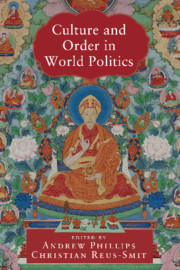Book contents
- Culture and Order in World Politics
- LSE International Studies
- Culture and Order in World Politics
- Copyright page
- Contents
- Additional material
- Contributors
- Preface
- Part I Introduction
- Part II Historical Orders
- 3 The Ottomans and Diversity
- 4 Qing and Twentieth-Century Chinese Diversity Regimes
- 5 Cultural Diversity and Coercive Cultural Homogenization in Chinese History
- Part III The Modern ‘Liberal’ Order
- Part IV Constitution and Contestation
- Part V Conclusion
- References
- Index
3 - The Ottomans and Diversity
from Part II - Historical Orders
Published online by Cambridge University Press: 25 December 2019
- Culture and Order in World Politics
- LSE International Studies
- Culture and Order in World Politics
- Copyright page
- Contents
- Additional material
- Contributors
- Preface
- Part I Introduction
- Part II Historical Orders
- 3 The Ottomans and Diversity
- 4 Qing and Twentieth-Century Chinese Diversity Regimes
- 5 Cultural Diversity and Coercive Cultural Homogenization in Chinese History
- Part III The Modern ‘Liberal’ Order
- Part IV Constitution and Contestation
- Part V Conclusion
- References
- Index
Summary
Conflicting narratives exist about Ottoman cultural practices. On the one hand, the Empire is lauded for its tolerance of cultural difference, with the famed ‘millet system’ upheld as a model of institutionalized cultural recognition. This sits side by side, however, with another view, of an order ruled by repressive Islamists. This chapter observes that widely different interpretations of Ottoman attitudes to diversity are possible because the empire was not static in this regard over the course of its more than six-hundred-year-old history. As with the modern international order, Ottoman history is marked by successive diversity regimes, in which a generally ‘latitudinarian’ approach to the management of diversity was punctuated by notable periods of cultural closure and repression. The chapter focuses on two such periods in the ‘long’ sixteenth and nineteenth centuries. In both periods, the shift to greater cultural intolerance and repression was propelled by institutional trends towards greater state centralization, interpolity completion involving external actors with ties to internal groups, and a governing (or legitimating) ideology viewing heterogeneity as a threat. In the sixteenth century it was heterodox Muslim communities that were targeted, with the empire thoroughly 'Sunnitised'. In the nineteenth century, by contrast, it was non-Muslim communities that bore the brunt of oppression, culminating most notably in the Armenian genocide of 1915.
Keywords
- Type
- Chapter
- Information
- Culture and Order in World Politics , pp. 49 - 70Publisher: Cambridge University PressPrint publication year: 2020
- 1
- Cited by



